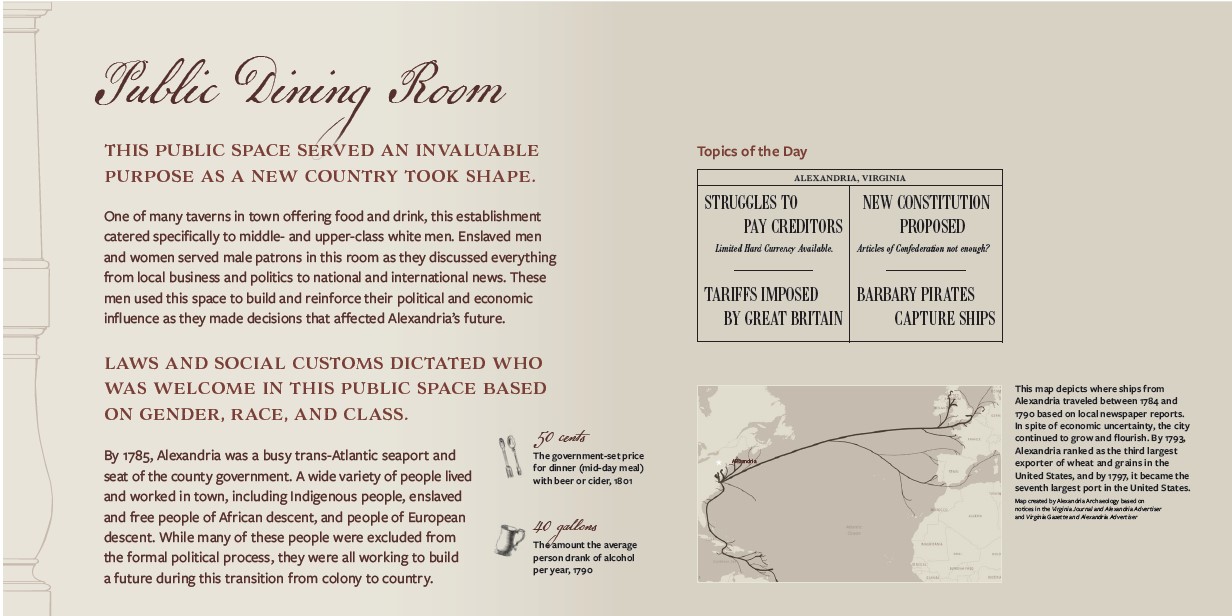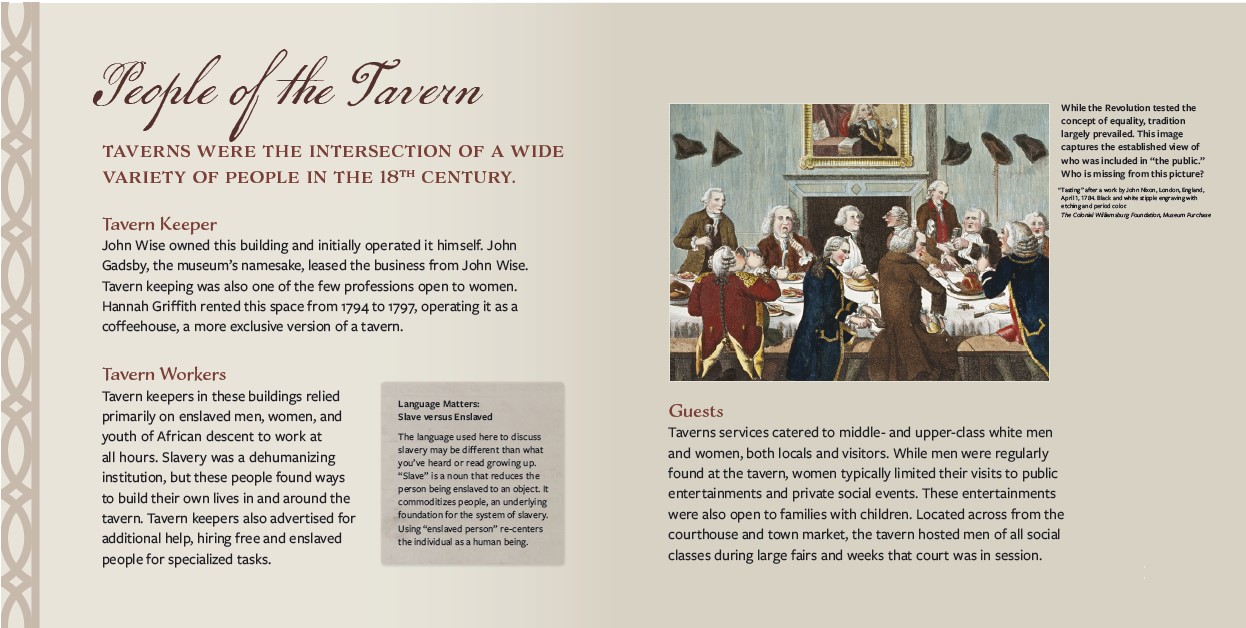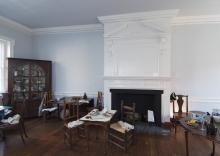
Tour Gadsby's Public Dining Room
Deep Dive Information
On-Site Exhibit

Public Dining Room
This public space served an invaluable purpose as a new country took shape.
One of many taverns in town offering food and drink, this establishment catered specifically to middle-and upper-class white men. Enslaved men and women served male patrons in this room as they discussed everything from local business and politics to national and international news. These men used this space to build and reinforce their political and economic influence as they made decisions that affected Alexandria’s future.
Laws and social customs dictated who was welcome in this public space based on gender, race, and class.
By 1785, Alexandria was a busy trans-Atlantic seaport and seat of the county government. A wide variety of people lived and worked in town, including Indigenous people, enslaved and free people of African descent, and people of European descent. While many of these people were excluded from the formal political process, they were all working to build a future during this transition from colony to country.
Fun Facts
- 50 cents: The government-set price for dinner (mid-day meal) with beer or cider, 1801
- 40 gallons: The amount the average person drank of alcohol per year, 1790
Topics of the Day
- Struggles to Pay Creditors: Limited Hard Currency Available
- New Constitution Proposed: Articles of Confederation not enough?
- Tariffs Imposed by Great Britain
- Barbary Pirates Capture Ships
Map: This map depicts where ships from Alexandria traveled between 1784 and 1790 based on local newspaper reports. In spite of economic uncertainty, the city continued to grow and flourish. By 1793, Alexandria ranked as the third largest exporter of wheat and grains in the United States, and by 1797, it became the seventh largest port in the United States.
View a larger map of the trade routes.

People of the Tavern
Taverns were the intersection of a wide variety of people in the 18th century.
Tavern Keeper: John Wise owned this building and initially operated it himself. John Gadsby, the museum’s namesake, leased the business from John Wise. Tavern keeping was also one of the few professions open to women. Hannah Griffith rented this space from 1794 to 1797, operating it as a coffeehouse, a more exclusive version of a tavern.
Tavern Workers: Tavern keepers in these buildings relied primarily on enslaved men, women, and youth of African descent to work at all hours. Slavery was a dehumanizing institution, but these people found ways to build their own lives in and around the tavern. Tavern keepers also advertised for additional help, hiring free and enslaved people for specialized tasks.
Guests: Tavern services catered to middle-and-upper class white men and women, both locals and visitors. While men were regularly found at the tavern, women typically limited their visits to public entertainments and private social events. These entertainments were also open to families with children. Located across from the courthouse and town market, the tavern hosted men of all social classes during large fairs and weeks that court was in sessions.
Language Matters: Slave versus Enslave: The language used here to discuss slavery may be different than what you’ve heard or read growing up. “Slave” is a noun that reduces the person being enslaved to an object. It commoditizes people, an underlying foundation for the system of slavery. Using “enslaved person” re-centers the individual as a human being.
Caption for image: While the Revolution tested the concept of equality, tradition largely prevailed. This image captures the established view of who was included in “the public.” Who is missing from this picture? (See a larger image, and its attribution).
Are Taverns Like a Restaurant?
Taverns did not have printed menus, but still offered some choices to customers based on what was available in town, either in season or preserved. The enslaved men and women working at the tavern were responsible for selecting, cooking, and serving the food.
In the 18th and early 19th centuries, life centered around three main meals:
- Breakfast: The first meal of the day included easily prepared items such as cheese, cold meats, and breads. These could be packed for an early stagecoach departure.
- Dinner: Served early to late afternoon, dinner was typically the largest meal of the day. It took more time to prepare and was served hot.
- Supper: The evening meal featured leftovers, often served cold.
The Public Dining Room here is set for dinner. We do not know exactly how the free and enslaved men and women presented food. They may have laid out a buffet where diners helped themselves or brought plated meals to individuals. Can you find the two different versions of service in this room?
Alcohol was part of daily life, consumed with every meal and in between. It was a substitute for water which was associate with causing illness. Cider and beer were cheap and easy to make locally, but distilled spirits like whiskey, rum, and brandy were also popular.
Mixed drinks included the following:
- Punch: rum, sugar, fruit juice, water, and spices
- Toddy: rum or brandy, water, and sugar
- Flip: beer, rum, molasses, and eggs or cream stirred until frothy
- Grog: brandy and water
Non-alcoholic drinks were also available. Tavern inventories show cups, pots, and brewing items for tea, coffee, and drinking chocolate.
Court records indicate the government regulated pricing, but the few existing tavern bills suggest these functioned as guidelines more than strict rules. [list of prices pulled from Alexandria County’s Court Order Books] For perspective, the $.50 dinner has a relative price worth of around $10 today. Check out MeasuringWorth.com for more about monetary values.
Furnishings in the Public Dining Room
Linen Basket (on bench under “People of the Tavern” panel): Enslaved women and hired laundresses cleaned everything by hand—napkins (called diapers), tablecloths, and bedding. They spent hours every week washing (in near boiling water), soaking, rinsing, scrubbing, drying, and ironing.
Painted Table: Painted tables were common in the 19th century and found on inventories (a lit of belongings) of tavern keepers. The mix-match of furniture is intentional. The tavern keeper purchased what was available, and large matching sets would have been costly. They were focused on maximizing profit and function more than creating an elegant setting in this space. This table and the chairs around it are reproductions, but those behind the rope are period antiques.
Why isn’t there a picture over the mantel? Taverns could have decorations on the walls, but specific records for this room are lacking.
Where’s the Bar? There could have been one, but no physical clues survive. The room’s layout has changed over time, destroying any original evidence. The dentilled cornice where the wall and ceiling meet is original, but this large mantel was installed in the 1930s.
Signage in the Hallway
Fire Bucket (hanging on hooks): The law required businesses to have fire buckets. If needed, citizens and volunteer firemen formed bucket brigades. Visit the Friendship Firehouse Museum on N. Alfred Street for more information.
Tour the Tavern
-
Welcome to Gadsby's Tavern Museum

-
Public Dining Room YOU ARE HERE